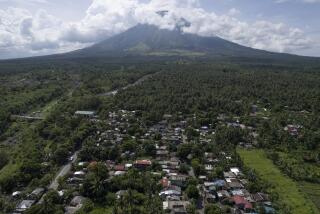Number of People Living Near Volcanoes Growing
- Share via
The number of people who live in areas at risk from volcanic eruptions will reach 500 million by the year 2000, according to a report by scientists of the U.S. Geological Survey.
About 90% of the threatened people will live along the subduction zones of the Pacific Rim’s so-called Ring of Fire, where 75% of Earth’s 850 active volcanoes are found, said Robert I. Tilling of the Geological Survey’s Western regional office in Menlo Park, Calif.
“Although eruption frequency and hazards severity have not increased in recent centuries, the problem of reducing volcanic risk necessarily becomes more acute with continuing explosive population growth, especially for many developing countries rimming the Pacific Ocean,” Tilling said in the report released last month.
He and another Geological Survey scientist, Peter W. Lipman, said more intensive monitoring of volcanoes, better techniques for predicting eruptions, more effective interaction with civil authorities and the public and improved international cooperation are necessary to deal with the risk.
Since 1600, there have been approximately 262,000 deaths from volcanic eruptions, about 76,000 in this century, according to the report.
But about 55,000 of the deaths in the 20th Century occurred from just two eruptions--those of Mt. Pelee on Martinique in the West Indies and of Nevado del Ruiz in Colombia.
A total of 29,933 people were killed in St. Pierre on May 8, 1902, when Mt. Pelee exploded, sending a huge fireball downhill and incinerating the coastal city. There was one survivor.
The Nevado del Ruiz deaths were caused by a catastrophic mudflow from the erupting volcano Nov. 13, 1985, which wiped out much of the city of Armero, killing approximately 25,000 people.
Of the six deadliest eruptions since 1600--Laki in Iceland in 1783, Unzen in Japan in 1792, Tambora in Indonesia in 1815, Krakatoa in Indonesia in 1883, Pelee and Ruiz--only Laki did not involve a subduction zone, Tilling said.
Subduction zones are places where the leading edge of one tectonic plate, floating on Earth’s mantle, over tens of millions of years dives under another, eventually causing great earthquakes and explosive volcanic eruptions that often emit high quantities of sulfur, causing a temporary cooling of the Earth’s climate.
More to Read
Sign up for Essential California
The most important California stories and recommendations in your inbox every morning.
You may occasionally receive promotional content from the Los Angeles Times.










